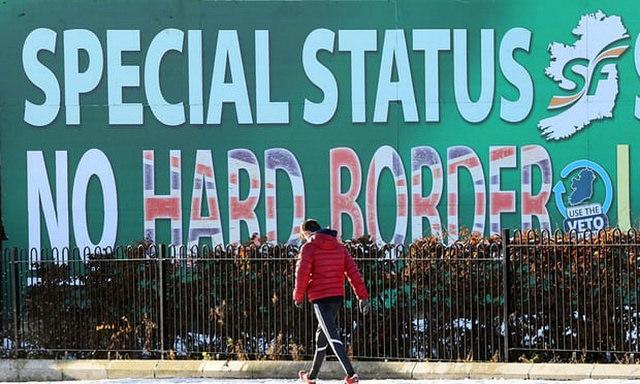
The Irish border is a potent symbol and evidence of how innovative policy can resolve seemingly intractable problems. The extreme political violence that plagued Northern Ireland and Britain only ended with an adjustment to thinking about sovereignty. Concerns about a resumption of violence with a hard Brexit seem ill-founded.
From partition in 1921 until the Good Friday Agreement of 1998, Northern Ireland’s history was complex, violent and characterised by a combustible mix of nationalism, sectarianism, oppression and terrorism. Successive UK governments unsuccessfully employed a range of approaches to a solution prior to 1998.
English plantations, begun under Henry VIII, expanded under Cromwell’s Protectorate. The lands confiscated by the Crown were passed to Protestant English, Scottish and Welsh immigrants. By 1703, 90% of the land in Ireland was owned by English nobles. The 18th century anti-Catholic laws instituted a harsh, discriminatory legal system that restricted land-ownership rights and access to education and political representation.
Partition was considered illegitimate by Catholics as it guaranteed an overwhelming Protestant majority in the six Ulster counties. By the 1922 establishment of the Irish Free State, the potential for future political violence in the north was well established.
Subsequently, the irredentist clauses in the 1949 Republic of Ireland’s constitution proved a continuous provocation to the unionist Protestants. The Catholics saw reunification with the south and its Catholic majority as the only way of addressing crushing discrimination. Protestants saw this as treasonous and justification for repression.
In the 1960s, a civil rights movement emerged in Northern Ireland. The Protestants responded by creating the loyalist paramilitary Ulster Volunteer Force in 1966. In 1969, the Provisional Irish Republican Army broke away from the IRA. This extremist republican paramilitary organisation became inextricably linked to Catholic causes.
The British Army was deployed in 1969 as sectarian violence mounted in Northern Ireland. But the presence of soldiers effectively changed the rioting between Protestants and Catholics into civil war. The militarisation strategy only fuelled the violence and was abandoned in 1975. The new approach of criminalisation of terrorism still ignored the political roots of the conflict. The biases and abuses of the Northern Ireland policing and legal system further inflamed the conflict.
Issues of overlapping identities and sovereignty lay at the conflict’s heart. Descendants of the English, Scottish and Welsh immigrants identified with the UK. They feared losing their identity and their dominance in a unified Ireland. The native Irish in the north identified ethnically and religiously with the south and saw unification as the only way of gaining justice, security and their civil rights.
Sovereignty was the key problem. Eventually a level of flexibility emerged over sovereignty that would be impossible today. The definition of the conflict was transformed among British policymakers, whose concerns over the erosion of UK sovereignty had long proved an obstacle to peace. The acceptance that this was at the same time a domestic problem and an international one was the key change.
The Good Friday Agreement recognised that Northern Ireland is unequivocally part of the UK, and the Republic agreed to withdraw its irredentist claim. The British government also agreed to not obstruct reunification if a majority of the Northern Ireland citizens expressed that preference. Thus, the agreement simultaneously recognised UK constitutional sovereignty and weakened it by accepting the prospect of the reunification of Ireland and modified the Republic’s view of its legal extent.
Initially, the domestic positions of the republicans and the unionists in the north were diametrically opposed on cross-border institutions. The former wanted immediate reunification and the latter were opposed even to any supranational political-administrative institution. In the agreement they found accord on the establishment of a north–south ministerial council.
In referenda, the agreement was approved by over 90% in the Republic and almost 72% in Northern Ireland.
The open border between the north and the south wasn’t the key political issue in the negotiations. Since 1922, the border between the north and the south has been only a notional political boundary rather than a physical barrier. While UK Prime Minister Theresa May said in a recent speech that ‘the seamless border is a foundation stone’ of the Good Friday Agreement, the right to free movement predates the agreement and even Irish and UK membership of the EU.
Notions of sovereignty between the UK and Ireland have long been somewhat indeterminant. The Common Travel Area came into being at the same time as the Irish Free State and gives nationals of the Republic of Ireland and the UK, Isle of Man and Channel Islands visa-free travel in each other’s jurisdiction. The Republic and the UK have committed in principle to retain the CTA after Brexit.
The Republic and the UK both joined the European Economic Community (forerunner to the EU) in 1973 and, at the time of the agreement, were subject to the four freedoms (movement of people, capital, goods and services). The EU’s modified concept of national sovereignty made compromises easier on all sides.
A hard Brexit would make sovereignty a major issue again. Northern Ireland voted against Brexit. A closed border would be economically and emotionally unpopular. Those sentiments could turn political were the UK economy, and especially Ulster’s, to suffer after Brexit. Northern Ireland’s economy is already under stress, while growth in the Republic is strong.
Calls to test the population’s appetite for reunification could emerge, and the result of a post-Brexit referendum on reunification would be uncertain given social and demographic changes in Northern Ireland. A referendum could also have knock-on effects among Scottish and Welsh nationalists.
The institutional causes of sectarian and political violence in Northern Ireland have been long ameliorated. If there’s a hard Brexit and it brings a hard border, the political threat to the UK’s sovereign unity might be the next big challenge for British policymakers. British nationalist fervour over sovereignty drives Brexit, yet, ironically, the outcome might truncate the UK’s national sovereign reach.